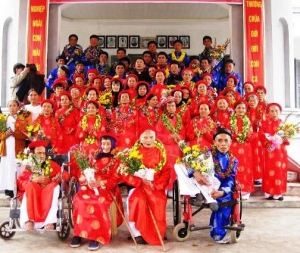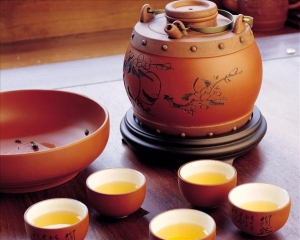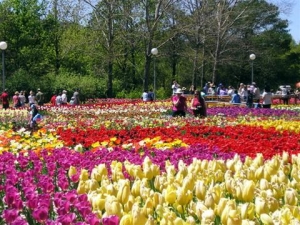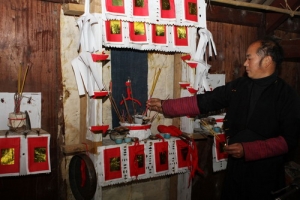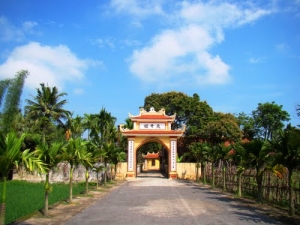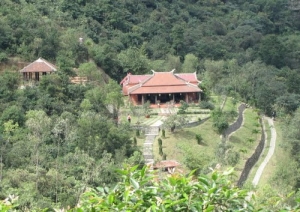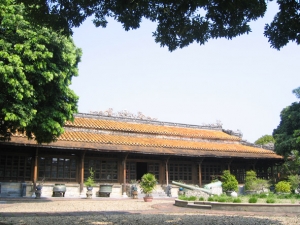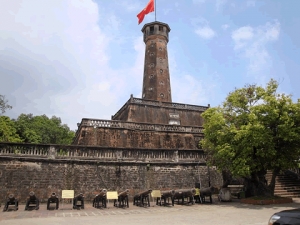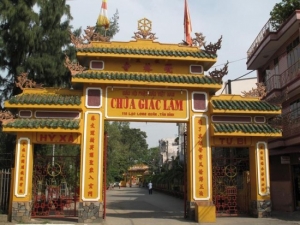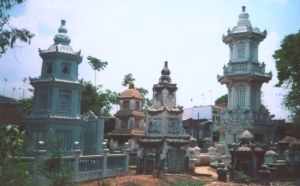
Asia Pacific Travel Team
Vietnamese's Traditional Celebrations of Longevity
Longevity wishing ceremony is to wish an elderly person longevity. That is a Vietnamese custom, when their grandparents or parents reach the old age, children show their profound gratitude to them by celebrating a ceremony to wish them good health and long life.
An old saying goes: "respecting the elder, he will give you more ages". The simple saying covers a philosophy of life in Vietnamese society, reminding us of the traditional moral standard, that is filial piety to our grandparents and parents.
Each passing year in a person’s life brings esteem and respect to their family and neighborhood. Formerly, at the age of 40 one was honored for being an old man or woman.
During the Tran Dynasty in the 12th and 13th centuries, the 40 year old emperor gave up his throne to his son to become a Buddhist monk.
According to village customs, a man of 50 is to be honored as an old man. Old men stop working and are no longer village officials; however, they are still invited to festivals and to sears in the communal house. Here, they are seated honorably on red-bordered mats.
Longevity still preserves deep significance and showing respect for older people is a tradition still practiced today. Presently, when grandparents or parents reach the age of 70, 80, or 90 years old, their children and grandchildren organise longevity ceremonies, which are generally held on their birthday or in the days during the Tet Holidays.
Such celebrations are occasions for children and grandchildren to show their devotion to their parents and grandparent. Celebrations for longevity, either large or small, display the family's joy of having a relative who has been able to lead a long life. This person is offered a red dress and other gifts and is invited to be photographed. Older people are filled with warm sentiments from their relatives and neighbors so that they will not feel lonely as they go through the weakness of the end of their lives.
Today, in almost every village or urban district, there is an Association of Longevity for the eldest, and women are equally venerated.
"One cup of tea, please!"
... is what you often here when walking along Hanoi streets, near a lamp post, under the shade of a tree, or next to a door where there is a low table with glass pots containing different kinds of candies, roasted ground nuts, and sugar coated cakes. This is a complete description of a make-shift tea shop, which is a very popular part of Vietnamese street life.
The owner skillfully lifts the cap of the tea cozy, takes out the tea pot, and then pours the hot tea into a small cup. The owner then hands the cup of steaming tea to the customer. Unlike northerners, who prefer hot steamy tea, people in the south would like to add ice cubes to their tea cups/glasses due to weather difference.
Tea drinking - an indispensable habit.
Vietnamese people have a nice habit of drinking tea. They drink it everywhere and at any time: at home, at workplaces, even in tea shops on their way to work, or at formal meetings, weddings or funerals. They also place it on altars as an offering to their ancestors on worshipping occasions. Whenever the locals feel thirsty, they are likely to look for this drink, in both summer and winter. A cup of iced tea in a hot day in summer not only refreshes your mind but also detoxicate your body. On the contrary, in winter, a sip of hot tea makes you feel warm inside and better able to cope with the outside cold temperatures.
Yet, tea drinking is not a recent trend in Viet Nam but attached to an ancient history as follows;
Tea drinking - from history to daily life...
Viet Nam is one of the largest and oldest tea-producing countries in the world. The Vietnamese have been growing tea for over 2,000 years. As early as in the 11th century, tea was used as a symbol to convey the essence of Buddhism. During the period of the Tran Dynasty from the 13th to early 15th century, tea assumed a philosophical value for the Vietnamese. In the 15th century, the Vietnamese polymath Nguyen Trai (1380-1442) lived as a hermit, renouncing the outside world for a life of "tea, poetry and the moon".
While tea has a special philosophical value for scholars and a long tradition in Vietnamese history, it has its own place today in the life of ordinary people living both in the cities and in the countryside. In the past, peasants could not afford expensive tea, so they grew tea on their own. Nowadays, tea is used to bind people together, for example, the peasant often invites his neighbor around for a chat over a cup of tea.They drink tea initially to thank the host for his hospitality, then throughout several tea sips, they open heart more, to share their feelings, to speak about the family, the company and finally to feel the nature savor of the cup of tea.
Besides a normal thirst-quenching beverage, tea is also considered a delicate and meaningful one. In the past, it used to be the leverage for poets’ inspiration. Up to now, the habit of leisure tea-drinking has helped refresh and polish the drinkers’ minds. Moreover, a person's character can be assessed by his or her tea drinking ways. Vietnamese people consider those who drink concentrated tea to be finely-mannered; and those who can pour tea into bowls arranged in a circle using a coconut scoop without spilling a drop will certainly enjoy the admiration of their tea-drinking peers.
Kinds of tea
Viet Nam has grown many and various types of tea such as che Tuyet, che Moc cau, che man, che chi … Each one is combined with a particular kind of flower: che man with chrysanthemum; che bup with hoa soi flowers; high quality che man and che bup with lotus, narcissus or jasmine. Some connoisseurs go so far as to row out to the middle of a pond to place small amounts of tea inside lotus buds in order to perfume it. An example is cum tea, grown by the Tay ethnic minority. Cum tea plants are allowed to grow until the buds are mature, then they are picked, and roasted in a pan until they are dry and the buds begin to curl up. The tea is then wrapped up in palm leaves to keep it fragrant.
The Vietnamese like to mix tea with flowers to make it more aromatic. Tea with lotus is very precious for Vietnamese people. This kind of tea was formerly reserved to the Kings. According to the predecessors, when the lotus blossoms in the afternoon, they put a sachet of tea in the pistil and then, they tighten it with the sheets of lotus. In the next morning, they take dew remained on the sheets and in mixture with the sachet of tea in the pistil. After having poured into the cup, the soft and fresh odor of lotus dominates the whole room.
The tea culture has sticked to the life and the heart of Vietnamese people for generations. And when they drink tea at a small mouthful, the tea savor makes them more off-hand and closer to one another. This has formed the culture of the vicinity and the affection between neighbors.
Source: VN beauty
Lunar New Year (Tet) in Vietnam
Vietnamese Lunar New Year, commonly known by Vietnamese as Tết Nguyên Đán or Tet, is the most important and popular holiday and also festival in Vietnam.
Do you know: Vietnam Lunar New Year 2012 will fall on January 23rd. 2012 is the year of Dragon
About Tet
Vietnamese Lunar New Year, commonly known by Vietnamese as Tết Nguyên Đán or Tet, is the most important and popular holiday and also festival in Vietnam. Similar to Lunar New Year in South Korea or China, Tet is celebrated for the arrival of the spring according to the Lunar Calendar - from the first day of the first Lunar month (around late January to early February) to at least the third day. Usually Vietnamese will be allowed to have five - seven days off from work to celebrate Tet holiday.
In 2012, the date for Tet is January 23rd (Year of Dragon).
In 2013, the date for Tet is February 10th (Year of Snake).
In 2014, the date for Tet is January 31st (Year of Horse).
Celebrations
There are many customs practiced by Vietnamese during Tet such as ancestral worshiping, giving away lucky money to children and elderly people, cooking traditional food, decorating house and many other unique customs. It can be divided into three periods: Tất Niên (Before New Year’s Eve), Giao Thừa (New Year’s Eve) and Tân Niên (the New Year).

Chung Cake and Tet Cake - the traditional flavour of Vietnam Lunar new year
Before New Year’s Eve: Overseas Vietnamese or pilgrims would try to come back to their homeland for family reunions, forgetting about troubles of the past and together hoping for a fruitful upcoming year. They would be busy decorating their houses with cherry blossom (in the northern region), hoa mai - Ochna integerrima (in the central and southern region) and other floral decorations such as kumquat tree, marigold, lavender or paperwhite flower along with traditional Dong Ho paintings and calligraphy pictures.
On the New Year’s Eve: the owner of the house will leave for outside a few minutes before midnight and come back just as the clock strikes midnight according to the traditional "xông đất" ritual. Performing this ritual, Vietnamese believe that if good things come to the family on the first day of the Lunar New Year, the entire following year will also be full of blessings.

Vietnamese Altar in a Tet holiday - filled with offerings
After lighting the incense on the family altar – a sign of ancestral worshiping, the whole family would gather together to enjoy the last dinner of year. The following days will be spent on visiting relatives, friends and teachers along with giving wishes and greetings such as “Chúc mừng năm mới” (Happy New Year) or "cung chúc tân xuân" (gracious wishes of the new spring) and also wishes of prosperity and luck. Children will receive red pocket from their older family members as a blessing for their new year.
Food for Tet
Food is also an especially important part of Tet; some dishes such as banh chung, banh day (tightly packed sticky rice with meat and bean fillings wrapped in leaves) or dua hanh are strongly associated with Tet’s images and requires extensive preparations.
Travel during Tet
Tet is a great time to visit Vietnam, though you may have mixed feelings about it. For example, Hanoi and Ho Chi Minh City will be deserted during Tet, shops will be closed, but you will feel the beauty of these two cosmopolitans in very different ways.
One of the tips that you will receive is to book your transportation as soon as you can, due to the influx of migrants returning home to celebrate Tet: train and air tickets will have exceptional price hike.
New Year Holiday of H’mong People
H’mong (Mong) people don’t wait for New Year Eve. For them, the first coo of the cock in the 1st early morning is the landmark to start a new year.

The H’mong includes many groups: Mong Do (White Mong), Mong Lenh (Flower Mong), Mong Si (Red Mong), Mong Du (Black Mong), Mong Sua (Mong Man). Now the H’mong popularity is about 558,000 people, gather in high mountain regions of Ha Giang, Tuyen Quang, Lao Cai, Yen Bai, Lai Chau, Son La, Cao Bang, Nghe An and Thanh Hoa provinces.
H’mong people have their own calendar, according to researchers, maybe they follow the calendar of Di ethnic group (China). Based on the calendar, their New Year Holiday is estimated in later November, earlier December in Vietnamese official lunar calendar. However, nowadays, almost H’mong groups enjoy Lunar New Year of Kinh people except for a small group, such as H’mong living in Moc Chau, that still remains their own Tet as well as the national one.
In December 25th and 26th, H’mong people start resting for Tet. They cover all producing devices, for example, the lu (lũ) closing formality is hold before closing the lu ron (lũ rốn), mill is unstitched, there is a large paper to implement formality with chicken, corn cake, wine...
Formerly, H’mong people don’t make chung cake (sticky rice cake). Now chung cakes are made but it maynot be in their Tet hanquet. They consider meat, wine and corn cake three dishes which can’t be lacked in the hanquet.

In 30th evening of midnight, they worship family ghosts (ancestors) with a pig, a cock ( a virginial one is the best). After that, they kill the pig and the cock (some rich families can kill a pig for meat in 28th and 29th). The cooked meat is worshiped then they enjoy the meal with wine until hearing the first coo of the cock.
From 1st on, H’mong people wear new clothes, shoes to go out. Papao throwing is one of Tet games that they are very interested in; besides that, there are more activities such as khon (khốn) dancing, u (ụ) dancing, pipe singing, folk music singing, horses racing, cross-bow shooting..

Especially, talking about H’mong Tet, it can’t be lack of Sai San Festival, also known as Gau Tao Festival ( praying festival). If a family have weak members or find it hard to have baby, they will set up a big symbolic tree in the start of village grass. Although this festival is known to be held by a family (the family is called the symbolic host), it’s a communitial festival, sometimes a village evenly take part in the festival of other one.

Gau Tao Festival is organized to respect ancestors of harvest, cattle and to pray for babies. The festival can long 3 days if it’s held every year or 9 days if the time period is each three year. This festival is the biggest one of H’mong people in year and it best demonstrates the features of H’mong culture in Tet holidays. In this festival, after ceremony part, there are charm-transferring (giao duyên) singing and playing favourite games activities as told below.
Tra Phuong (Thien Phuc) Pagoda, Hai Phong
This pagoda of the Nguyen Dynasty includes an entrance hall including five compartments and an apse including three compartments. Tra Phuong Pagoda is one of the centers belonging to the Buddhist architectural system of the Mac Dynasty. First built under the Ly Dynasty (1010 - 1225), the pagoda was initially called Ba Dinh. It is said that the original pagoda was located on a hillock in the south which was 200m far from the current one. It is said that Mac Dang Dung once took refuge in the pagoda and escaped from his enemies. With the establishment of the Mac Dynasty (1527 - 1592), Dang Dung reconstructed the pagoda and renamed it as Thien Phuc.
Apart from normal festivals, the pagoda honors its founders on every lunar January 22. Tra Phuong Pagoda today is both a site of historical and cultural importance and a Mac Dynasty art museum of Hai Phong City.
Serene Huyen Khong Son Thuong Pagoda
located halfway up the Cham mountain in the suburbs of Hue, Huyen Khong Son Thuong Pagoda is well known throughout the region for its romantic and heavenly scenery. The tranquil setting of this spiritual getaway is a magnet for those seeking a peaceful alternative to the city and is especially attractive to literature and art enthusiasts.
Hue Royal Antiquities Museum
On August 24, 1923 King Khai Dinh (1916-1925) issued a decree on establishing the Khai Dinh Museum, the forerunner of the present-day Hue Royal Antiquities Museum. The purpose of setting up the museum was defined clearly, i.e. talents of a nation are reflected through the fine arts works that describe social activities, rituals, political and daily events…
From the very beginning of its existence, the museum was entrusted with the duty, “to revive generations of artisans who had built up the glorified Hue royal court.”
Hue Royal Antiquities Museum, now under the administration of the Hue Monuments Conservation Centre, has preserved and displayed nearly 10,000 antiquities relating to the life during the Nguyen Dynasty (1802-1945). The main showroom is Long An Palace, which is considered one of Viet Nam’s most beautiful, existing palaces.
Long An Palace is located on an area of 6,330m², its main showroom for the antiquities is 1,200m². There are 16 typical collections of items displayed inside and outside the Palace, including many of Vietnam’s precious handicraft fine arts objects such as Hue enamelled bronze wares, sets of gold tree branches and jade leaves, sets of wooden articles inlaid with mother
 |
|
A screen made of silver |
-of-pearl or painted with red lacquer trimmed with gold, and copper antiquities made by Hue artisans. Long An Palace was built under the time of King Thieu Tri (1841-1847). It consists of seven compartments and two annexes plus 128 pillars made of precious timbers. The entire wooden parts are carved with beautiful scenes, the four sacred animals (dragon, lion, tortoise and phoenix) and more than 1,000 poems in Chinese scripts. Among them, there are two poems composed by King Thieu Tri, each having 56 words and engraved in the shape of the eight-sign figure that turns into 64 different seven- and five-word verses.
Long An Palace is a valuable museum, which displays poetic and painting works, a collection of literary pieces, historical references and stories, thoughts of nature and rules laid out by King Minh Mang (1820-1840), King Thieu Tri (1841-1847) and King Tu Duc (1847-1883). The Palace is a wonderful combination of architecture, poems and paintings that are reflected clearly through the carvings on wood. The art works and utensils of the Nguyen kings and royal families were made by
 |
|
Inlaid designs and poems on the drawer’s face |
skilful Vietnamese artisans with such materials as gold, silver, jade, ivory, glass, stone, wood, leather, fabrics, paper, bamboo, rattan and terra cotta. In addition, 80 objects of the Cham ethnic people found in 1927 in O and Ly areas and Tra Kieu ancient capital are considered valuable objects of the Far East and the world over. In the palace, there is a folding screen painted by painters of the Indochina College of Fine Arts 70 years ago. It was engraved and painted with pictures of 78 Hue women wearing the Ao Dai with different designs and colours. Outside the palace, there are on display a collection of 30 cannons of different types made in the Nguyen Dynasty and previous time. Besides cannons, in the court yard there is a collection of stone statues and stelae made in the Le Dynasty (1428-1527, 1533-1788) and the Nguyen Dynasty (1802-1945). The most significant collection is that of large bronze bells, cauldrons, urns and pots.
When visiting Hue Royal Antiquities Museum, visitors will have a chance to enjoy the masterpieces made by Hue artisans over 700 years of development in the imperial city of Phu
Xuan – Hue.
Hanoi Flag Tower
Flag Tower is located on Dien Bien Phu street, Ba Dinh district, Hanoi; near Ba Dinh Square. Hanoi Flag Tower, also called Cot Co, is one of the rare architectural works in Hanoi . It was used by French troops as an observation tower and communication station between command headquarters and adjacent military posts.
It was built in 1812 and is composed of three platforms and a tower. The words Nghenh Huc, meaning "to welcome dawn's sunlight," are inscribed on the eastern door. The western door bears the two words Hoi Quang, meaning "to reflect light," and the southern door, Huong Minh, meaning "directed to the sunlight." The tower receives sunlight through 36 flower-shaped and six fan-shaped windows.
Giac Lam Pagoda
Giac Lam Pagoda was built in 1744, under the reign of Lord Nguyen Phuc Khoat. Unlike many other local religious structures, it has not been renovated since 1900; the architecture, layout, and ornamentation remain almost unaltered.
Location: Giac Lam Pagoda (also known as the Cam Son or Cam Dien Pagoda) is located at 118 Lac Long Quan Street, Tan Binh District, Ho Chi Minh City.
Characteristic: Giac Lam Pagoda was built in 1744, under the reign of Lord Nguyen Phuc Khoat. Unlike many other local religious structures, it has not been renovated since 1900; the architecture, layout, and ornamentation remain almost unaltered.

Considered the oldest pagoda in HCM City, Giac Lam was set up in the mid 18th century and restored in the early 19th and 20th centuries. It creates a scenic spot in Phu Tho Hoa, Tan Binh District.
This pagoda used to be a thatch-roofed wooden temple which Ly Thuy Long and his wife built for their religious life. A few years later, an old monk of the Lam Te discipline visited and was asked to stay and be their teacher. The pagoda has had a 230-year history of eight chief monks.
The main section of the pagoda is for worshipping A Di Da (Amitabha) Buddha, with Ca Diep (Casyape) on his right and A Nan (Anand) on his left. Both are the great disciples of Thich Ca Mau Ni (Sakyamuni) Buddha. In front of A Di Da are Sakyamuni, Maitreya and bodhisattvas. At both sides of the walls, there are statues of 1810hans (arhats) and 10 kings of the hell.
 In front of the altar there are 49 oil lamps and 49 statuettes of bodhisattvas. Buddhists pray here for peacefulness and health. They write their names and their relatives' names on a piece of paper and have it stuck on the grand bell. They believe that when the bell is struck, its echoes go to heaven and hell, taking along their wishes.
In front of the altar there are 49 oil lamps and 49 statuettes of bodhisattvas. Buddhists pray here for peacefulness and health. They write their names and their relatives' names on a piece of paper and have it stuck on the grand bell. They believe that when the bell is struck, its echoes go to heaven and hell, taking along their wishes.
Behind the main shrine is the altar for worshipping the pagoda's head monks.
Giac Lam Pagoda has more than 100 ancient statues, signboards and tablets with pictures of four kinds of precious flowers and four species of sacred animals. In particular, there is a pair of tablets decreed in 1804 by King Gia Long, and two parallel sentences donated by Gia Dinh Citadel Governor Trinh Hoai Due.
The pagoda is surrounded by 50 ancient towers with ingenious sculptural lines. Its yard is paved with red square tiles. Both sides of the pathway have many precious ornamental flowers and plants.
In front of the pagoda is a big bodhi tree, a gift from Sri Lankan great monk Narada in 1953. In its shade is the statue of Guan Yin Bodhisattva. On one side of the pagoda is a white-flower ochna tree of about 100 years of age. In the front yard is a tower for preserving the remains of monks after their cremation.
Giac Lam Pagoda has been recognized as a national historic heritage site.
Giac Vien Pagoda
Giac Vien Pagoda is located on Lac Long Quan Street in Ho Chi Minh City, about 10km south-west of downtown Ho Chi Minh City, amid a quiet area near Dam Sen (lotus pond) tourist park.
Location: Giac Vien Pagoda is located on Lac Long Quan Street in Ho Chi Minh City, about 10km south-west of downtown Ho Chi Minh City, amid a quiet area near Dam Sen (lotus pond) tourist park.
Characteristic: It has the ancient architecture of the pagodas built in the Nguyen dynasty of the 19th century, and typical characteristics of the southern area in terms of the architecture, design and arrangement of the worshipping shrines.
 In 1789, a monk who was in charge of taking care of the restoration of Giac Lam Pagoda, built a small pavilion for his daily prayers, called Quan Am Cac (Kwan Yin Pavilion). In the third year under king Tu Duc's reign (1850), the pavilion was rebuilt and named Giac Vien Pagoda. When building Dam Sen tourist park, the Management Board decided to preserve Giac Vien Pagoda intact and incorporate it into the park, making the park more attractive due to its cultural-historical value.
In 1789, a monk who was in charge of taking care of the restoration of Giac Lam Pagoda, built a small pavilion for his daily prayers, called Quan Am Cac (Kwan Yin Pavilion). In the third year under king Tu Duc's reign (1850), the pavilion was rebuilt and named Giac Vien Pagoda. When building Dam Sen tourist park, the Management Board decided to preserve Giac Vien Pagoda intact and incorporate it into the park, making the park more attractive due to its cultural-historical value.
Giac Vien Pagoda has typical features, of southern Vietnam. The main shrine, also a big hall, is 360 sq.meter in area, and used to worship Buddha. To its East and West, there are corridors, a room for the monks to prepare clothing before assisting the Superior Monk, and a large and spacious compartment at the rear. Along the corridors, there are small altars with worshipping items. In particular, there are rows of wooden pillars engraved with parallel sentences. The letters are carved delicately and painted with red lacquer and trimmed with gold. Around them there are decorative designs of leaves and climbing plants. All 153 statues in the pagoda are made of jack wood. The faces and postures of the statues look honest and they are placed low, creating a close feeling between them and the viewers.
 The most attractive items are 60 plates, which are engraved on both sides made of jack wood. They are and made with gold. The most beautiful plate is engraved with 18 fat, honest and smiling Arhats, with each riding on the back of a buffalo, a cow, a pig, a goat, etc. Some plates are engraved with birds, ducks, fish, etc., but all looking alive. Other plates are carved with fruits popular in the South, such as coconut, mangosteen, durian, rambutan, etc. These wooden engravings are the only ones that have been kept intact in Vietnam.
The most attractive items are 60 plates, which are engraved on both sides made of jack wood. They are and made with gold. The most beautiful plate is engraved with 18 fat, honest and smiling Arhats, with each riding on the back of a buffalo, a cow, a pig, a goat, etc. Some plates are engraved with birds, ducks, fish, etc., but all looking alive. Other plates are carved with fruits popular in the South, such as coconut, mangosteen, durian, rambutan, etc. These wooden engravings are the only ones that have been kept intact in Vietnam.
The Buddhist spirit of the ancient Viet people, during their migration South, accepted different religious tendencies and sects, on condition that they were useful to society. This is clearly seen through the items preserved at Giac Vien pagoda. For this reason, Giac Vien Pagoda became a centre for worshipping ceremonies and discussions on Buddhism of the six southern provinces in the 19th century- a prosperous time for Buddhist followers and talents whose works remain valuable until today.
Giac Vien Pagoda has been classified by the State as a cultural relic and a mini-museum of wooden engrav ings of historical and artistic Value. For this reason, it attracts a lot of researchers and visitors all year round.


